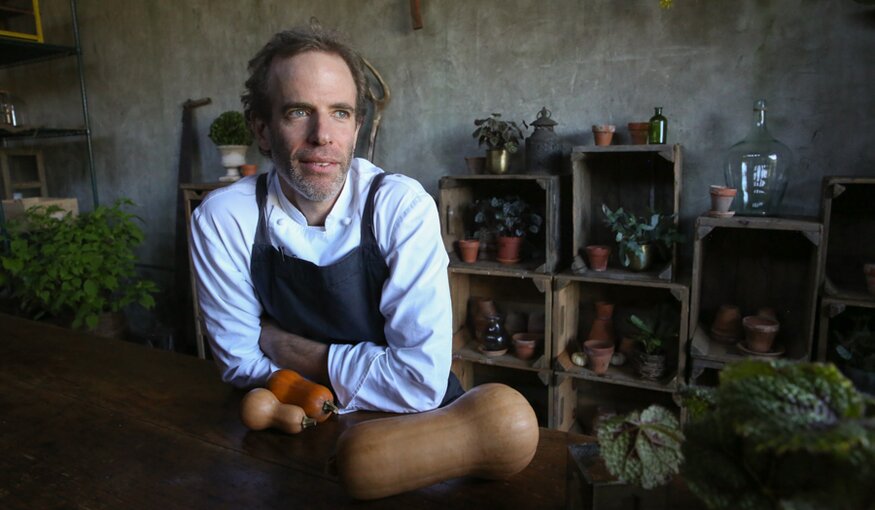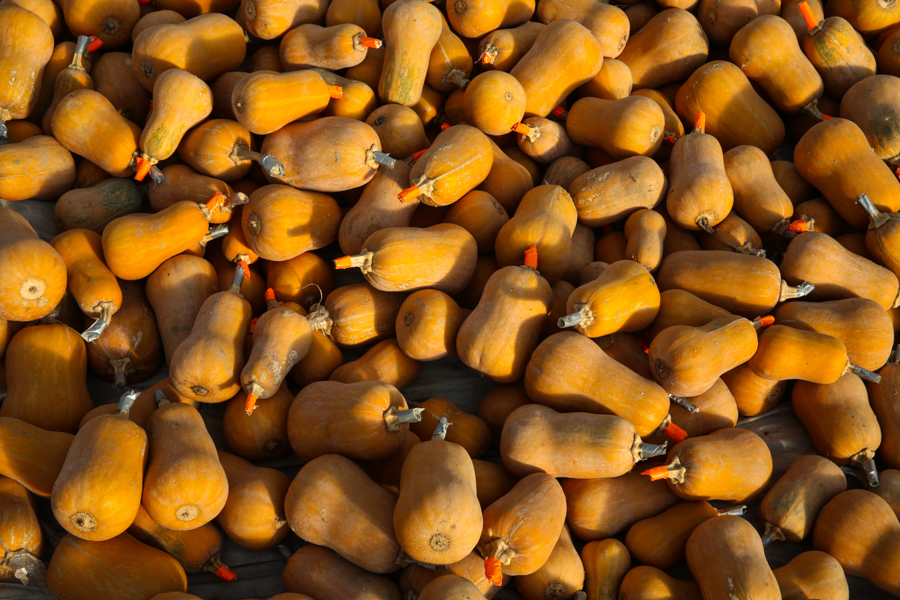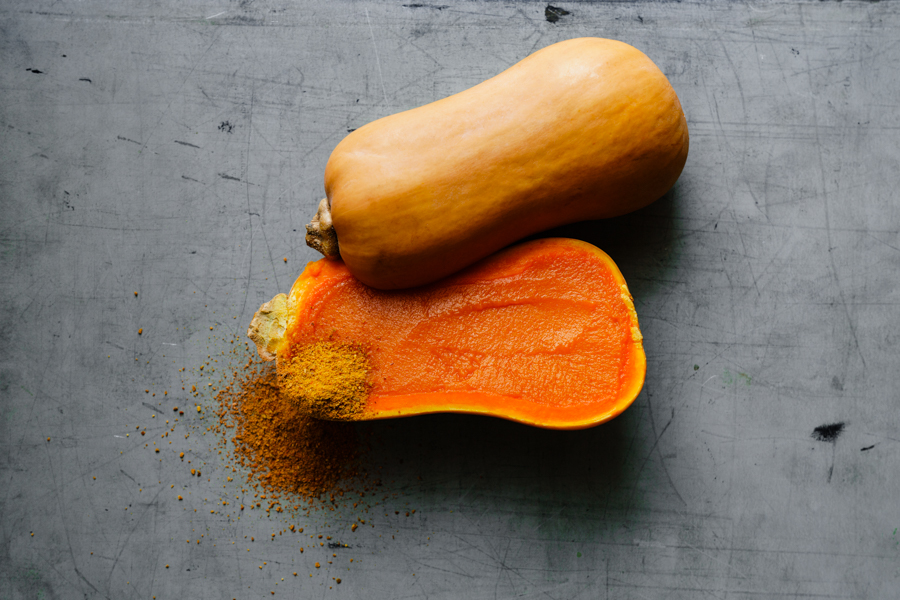Chef Dan Barber Talks Deliciousness Through Plant Breeding

6 December 2018
Interview and photos: LM Salazar | Crop Trust
I met up with world-renowned chef Dan Barber during my recent #CropsInColor trip to the Northeast region of the United States. Dan has become a leading voice in the global conversation that is taking a close and critical look at our current food system.
A modern-day Renaissance man, if you will, Dan is just as comfortable in his kitchens – at Blue Hill restaurant or Blue Hill at Stone Barns – as he is in a farmer’s field, examining new crop varieties that Row 7 Seed Company – the company he co-founded with plant breeder Michael Mazourek – will eventually distribute; or on a stage, talking to large audiences about food culture; or behind a desk, maybe writing a follow-up to his New York Times bestselling book The Third Plate: Field Notes on the Future of Food.
At Blue Hill at Stone Barns, as I waited for him in a small shed behind the restaurant, the afternoon’s October light came in softly, at an angle, through the open frame of wooden doors. Outside, across a dirt road, rows of vegetables colored the fields of Stone Barns Center for Food and Agriculture, a non-profit farm and education center. Dan soon walked in, neatly dressed – wearing a white chef’s iron-pressed, spotless shirt and a black, chest-high apron – and holding three squashes. He sat down, smiled and was ready for our chat.
Luis Salazar: Let’s begin with squash. What comes to mind when you think about this crop? What does it mean to you as a chef? And what do you think it means to folks in this region?
Dan Barber: Squash to chefs, in the Northeast especially, is a miracle crop because it enables us to work with something that is hearty and delicious, not to mention super nutritious. It also allows us to enjoy a crop over the course of a winter -- a long, long winter -- where there are dark clouds of cabbages and root vegetables. It is a crop that can be harvested in the fall and stored beautifully through April and May, when spring starts. That is something we cherish.
The harvest of squash is a little like being on the train platform and you just missed one train, which is the summer, and you are a little bit too early for the next train, which is fall. And whenever I see squash come out of the field, I start thinking about our fall menu.
LS: Squash for you, particularly the now famous Honeynut, is at the root of your active involvement in developing new crop varieties, where the focus is flavor instead of the usual agronomical traits. Can you share briefly how this came about? In other words, what’s the origin story of Row 7 Seed Company?
DB: In many ways the origin story of Row 7 was a conversation that I had with Michael Mazourek, the brilliant squash and cucurbits breeder at Cornell University. Michael came in for dinner at Blue Hill and I was struck by the questions he was asking. He’s like an amazing chef in many ways, and that night this is what was on his mind: “How do you write a recipe for deliciousness starting at the seed level?”
I liked his thinking and invited him back to the kitchen. There was a chef preparing a squash and I said, half-jokingly: “If you’re such a great breeder, why don’t you breed a butternut squash that actually tastes good?” [Pause] I think what I said was: “Why don’t you shrink the thing?” because really, what I was interested in was something that had a lot less water and could pack in flavor.
With butternut squash, chefs – and home cooks too – figure out these heroic ways to bring out flavor – roasting and caramelizing and adding butter, maple syrup and sugar – these kind of hula-hoops you run through to get squash to taste good. But what if you could actually breed it?
The result of that conversation was, eight years later, this Honeynut squash that has now penetrated not just farmers’ markets coast-to-coast, but supermarkets and large-scale food distributors. It is one of the more exciting squashes to come out in recent years. Good yield and ten times the flavor of the butternut. And it’s a hardy crop.
The Honeynut squash took off starting in the kitchens of chefs and went viral – in many ways because there was this great correspondence between true deliciousness and a great economy for the farmer.
That got us thinking about a company that could do more of this with other vegetables, bringing chefs and breeders together to write a recipe from the ground up. The trick though with squash and other vegetables is to ask: “How do you continue to improve?” Instead of looking at a butternut squash and saying it is finished, ask: “What is the next generation going to look like?”
LS: And in this case, does the next generation of the Honeynut look like that mini butternut squash you are holding?
DB: What I am holding here is an experimental variety called the 898 squash, named for its trial number. It’s Michael Mazourek’s next iteration of the Honeynut. And the idea here was to primarily increase the amount of time that it could store.
The Honeynut has very high sugar content and thin skin, and markets are out of the Honeynut business by Christmas because it won’t store.
LS: Enhancing taste by sacrificing storage. That was the compromise.
DB: Now this 898, as delicious as the Honeynut, will last until March. It’s very much a game changer for how we think about the Honeynut and enables it to reach a lot more people, with a lot more storage potential. It also yields more fruit per plant [and he holds up the Honeynut].
My point of introducing the 898, and the point of Row 7, is to get around this mindset where we say that anything new is bred to be tasteless and nutrition-less. But anything old that was passed down through generations is sacrosanct and we dare not touch it because our great-great-grandparents were using it and it’s meant to be honored.

Norwich, NY -- dozens of Honeynut squashes inside a high tunnel at Norwich Meadows Farm will soon be transported to Manhattan’s Union Square Greenmarket, where Zaid Kurdieh, owner of Norwich Meadows Farm, will sell them to restaurants and customers who visit his stand. Photo: Luis Salazar/Crop Trust

898 Puree and Squash Skin Crumble – a Dan Barber recipe; image courtesy of Blue Hill.
Actually, the best way to honor old varieties is to continue to update them.
And modernize them in the sense that they become more regional, more prolific; they can have better yield, have better disease resistance. You work towards a system of seed breeding that continually updates varieties, a system that influences the food culture – chefs in particular. To innovate off of what is old is actually to honor what’s old. That’s the spirit of Row 7.
LS: So how is Row 7 Seed Company translating this spirit into concrete actions?
DB: What we try to do while supporting breeding work is to see region-specific what new variety is it that really sings there -- in a particular soil, ecology, climate? Whereas squashes today are bred for a one-size-fits-all. The same variety is meant to grow in California as it is meant to grow here in the Hudson Valley, and in North Dakota, and Texas, and Canada, Mexico and China. That’s the one-size-fits-all approach to crop breeding, which, from a distributor point of view, and the market place, it makes sense. I see the ease and the logic behind it. But from a biological or ecological perspective, that’s at odds with how the biological world works. And it’s also at odds with how the gastronomical world works.
The gastronomical world is obsessed with, and puts its money on, diversity. And it’s a diversity of flavors that you are looking for. That’s what wakes up a palate. And that’s what wakes up a menu. A chef who is looking to deliver on deliciousness -- which all chefs are -- is looking at diversity as the key component to that end.
So it’s nice to see that the best gastronomic pursuits and the best ecological pursuits are one and the same thing. Diversity, and the recognition of diversity and a sense of place, and the promotion of great taste and nutrition, are all based on the principles of hedonism. That’s a really great position to be in.
LS: To develop these new, exciting crop varieties that populate your menus, breeders need to tap into the wealth of diversity that is housed in genebanks. Can you say a few words about the need to safeguard and make available this reservoir of genetic material?
DB: As obsessed as I sound about updating crop varieties, I appreciate the fact that to update them, you need this diversity. It is not about turning my back on heirlooms or old varieties; it’s recognizing that the genetic diversity found in them is key to building the future strength of both a menu and a food system.
We need to invest on both – in the idea that updating and modernizing crops in an appropriate way is fundamental, but also recognizing that in order to achieve that, the tools and the toolbox need to continually be respected and cared for. And that takes time and money and resources and attention – which is part of the work that the Crop Trust is doing.
#CropsInColor celebrates the critical importance of crop diversity and its beauty and cultural relevance across different landscapes. It highlights many key actors in our food systems – from consumer to farmer to seed bank – who are doing their part in safeguarding, making available and using crop diversity. #CropsInColor is made possible by the generous support of Corteva Agriscience.
Category: Squash
